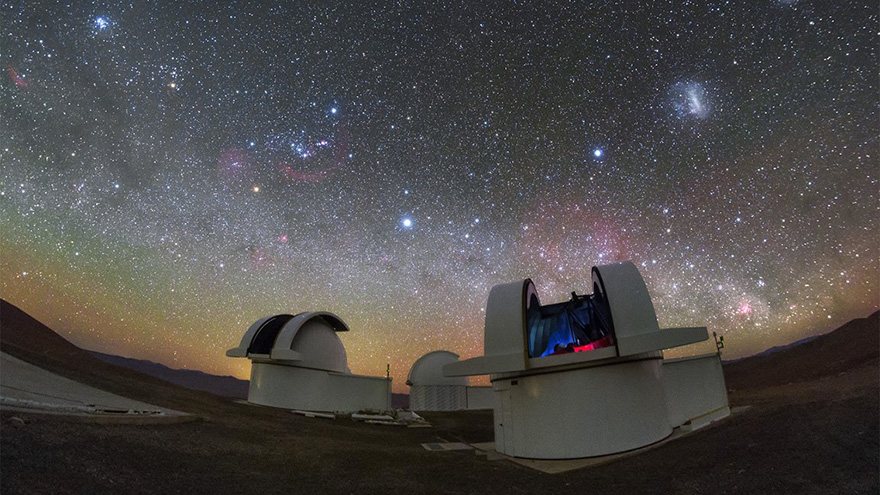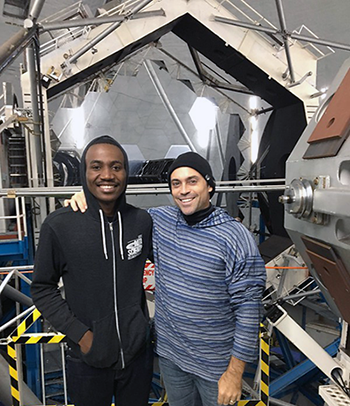The Science of…Cool Stars and Super Earths
November 2, 2022 | By Michelle Franklin
An international team of scientists recently announced the discovery of two 'super-Earth' type planets orbiting LP 890-9. Also known as TOI-4306 or SPECULOOS-2, this small, dim star is the second coolest star around which planets have been detected, after TRAPPIST-1. This discovery is published in the journal Astronomy & Astrophysics (PDF). UC San Diego Professor of Physics Adam Burgasser and graduate student Christian Aganze were part of the research team. In this edition of “The Science of…” Adam and Christian explain cool stars, super Earths and why age matters.

Q: What are cool stars?
Adam Burgasser: The terms “cool” and “low mass” are relative — these stars are still really hot and massive compared to the Earth. But they’re cooler than some of the more massive stars in our galaxy, which can get up to 40,000-50,000 degrees Kelvin at the surface — that's almost 10 times hotter than the Sun. Cool stars are around 3,000 degrees Kelvin or less, and take their time burning through hydrogen because they don't fuse as efficiently as more massive stars. So compared to the Sun, LP-890-9 is a cool star.
Q: Is the temperature of a star a function of its size?
AB: Yes! Hotter, more massive stars are physically bigger, while cooler, less massive stars are quite a bit smaller. There are some exceptions: when stars have used up all their hydrogen, they go through these phases where they bloat out, so you can get really big, but very low-temperature red giants. There is also the white dwarf, which is the remnant core of a star that's blown off its atmosphere. These are tiny, about the size of the Earth, but they can be hundreds of thousands of degrees Kelvin.

Q: This discovery was a worldwide team effort. What was UC San Diego’s role in particular?
AB: My scientific expertise is in understanding the chemistry, temperature, mass and ages of low-mass stars through spectroscopy, and that has been our team’s primary role. The team we are working with is specifically targeting small stars to search for planets by the transit method, using a system of telescopes around the world called SPECULOOS. A transiting planet is one that passes in front of the star, producing a brief but periodic dimming of the star’s light. The advantage of looking at small stars is that the smaller the star, the smaller the planet you can detect by this method. In addition, the habitable zones around these stars, which is the distance at which a planet could potentially have liquid water on its surface, is much closer to the star, so such planets are more likely to transit. We also see evidence that small stars have more rocky, terrestrial worlds. If your main objective is to find a place where life like that on Earth might exist, a rocky world with water on its surface is a good place to start.
Q: Why is it important to understand the characteristics of these cool stars?
AB: The properties of the star tell us a lot about the properties of the planet. Our primary contribution for this paper was to use spectroscopy to measure the temperature and chemical composition of LP-890-9. This is important because we find that stars containing greater quantities of heavy elements (meaning heavier than helium), have more rocky worlds orbiting around them. Knowing the star’s temperature helps use determine where the habitable zone is and whether the planets we find are located in this zone.
Q: Why do small stars live longer?
Christian Aganze: Bigger stars have more fuel (hydrogen), but they burn through it quicker, so they die “young.” Smaller stars don’t have as much hydrogen, but they burn through it much more slowly. These types of tiny stars can live for trillions of years. For context, the universe is only 10 billion years old, so this star is going to outlive everything. Even though LP-890-9 may have been around for the entire age of the universe, it's still very early on in its life.
Q: Why is it important to know the age of stars?
CA: I can think of two reasons: first, we want to understand the long-term evolution and dynamical properties of these planets. For instance, with TRAPPIST-1, we wanted to understand how the long-term evolution of the star affects the evolution of its planet. Second, we want to know the occurrence rate of these systems: how many stars have planets? How does this depend on mass or age?
It’s hard to determine the age of these cool star systems. There aren’t many age indicators for small stars because they live for such a long time. You can use the motion of the star through the Milky Way as a guide: if the star is moving with other old stars or other young stars, you can assume that it is roughly the same age. But even with these indicators, there is still uncertainty — the age could be uncertain by a billion years! One thing I'm interested in doing in my research is finding a better age indicator for these old stars.
Q: Next you will try to study the atmosphere of these two planets. What do you hope to find?
AB: Again, if we go back to the idea of whether these planets are habitable, aside from water, the other thing we know about Earth is that it has an atmosphere that keeps the oceans from evaporating, protects us from ultraviolet rays, and gives us something to breath. The first objective would be to show whether these small planets have atmospheres or not — that hasn't been done yet for small terrestrial worlds like these. We've been able to detect the atmospheres of some very giant planets, but small planets like the Earth have thin atmospheres that are hard to detect. If we can prove they have any kind of atmosphere, then we can start finding out what is in the atmosphere and look for so-called biosignatures — indications that life is present.
Q: As astrophysicists, you actually do a lot of data analysis. Who has access to the data?
AB: Our students have been involved in this and other exoplanet follow-up programs. We get a lot of our data from the Lick Observatory in San Jose, and that data is often analyzed, reduced and studied by graduate and undergraduate students at UC San Diego. Christian was involved in this study, and we’ve had other undergraduates who are involved in other spectra we get from the same telescope. We’re very fortunate to have these resources for our students.
CA: We are fortunate to have the UC observatories and a community of astronomers who create tools that make it much easier to analyze the data and get to the science of discovery.
Q: Is the data analysis exciting? Is there still a sense of wonder?
AB: Data is definitely exciting! When we get a new spectrum or when the James Webb Space Telescope downloads a new image of the deep sky — that's super exciting. We definitely get excited when we have new observations and new data to play with, as we often find surprises, like a new planetary system!
